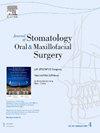基于胚胎起源和骨化模式的颅面骨密度的比较分析。
IF 2
3区 医学
Q2 DENTISTRY, ORAL SURGERY & MEDICINE
Journal of Stomatology Oral and Maxillofacial Surgery
Pub Date : 2025-10-01
DOI:10.1016/j.jormas.2025.102388
引用次数: 0
摘要
目的:骨从不同的胚胎起源发育,并通过软骨内或膜内骨化形成。本研究旨在探讨不同胚胎起源和骨化过程的骨密度是如何变化的。材料与方法:共43例受试者(男性12例;平均年龄68.3±9.9岁,有跌倒史,疑似面部和腕部骨折。参与者随后根据骨质疏松程度根据股骨颈面骨密度(aBMD)的t评分分为三组。aBMD采用全髋关节、股骨颈和腰椎的双能x线吸收仪(DEXA)测量。桡骨远端、舌骨和颅面骨(包括下颌骨、上颌骨、额骨、顶骨、颧骨和颞骨)的骨密度采用三维重建计算机断层扫描图像进行评估。结果:重建桡骨远端模型的平均Hounsfield单位在不同的骨质疏松程度有显著差异。然而,在颅面骨和舌骨模型中没有发现显著差异。轴骨和尾骨的骨密度之间存在显著的相关性。相比之下,颅面骨表现出强烈的内部相关性,但与轴骨或阑尾骨的相关性很小,揭示了受胚胎起源和骨化过程影响的不同骨密度模式。结论:不同的胚胎来源和骨化过程导致不同的骨密度模式。这些结果强调了在预测骨折风险或计划涉及骨准备的手术时,特别是在颅面区域,仔细考虑DEXA结果的重要性。本文章由计算机程序翻译,如有差异,请以英文原文为准。
A comparative analysis of craniofacial bone density based on embryonic origin and ossification patterns
Objective
Bones develop from various embryonic origins and are formed through either endochondral or intramembranous ossification. This study aimed to explore how bone density varies across bones with different embryonic origins and ossification processes.
Materials and methods
A total of 43 participants (12 males; mean age 68.3 ± 9.9 years) with a history of falls and suspected facial and wrist fractures were included. Participants were subsequently divided into three groups based on levels of osteoporosis based on the T-score of the areal bone density (aBMD) at the femoral neck. aBMD was measured using dual-energy x-ray absorptiometry (DEXA) of the total hip, femoral neck, and lumbar spine. Bone densities of the distal radius, hyoid, and craniofacial bones, including mandible, maxilla, frontal, parietal, zygomatic, and temporal bones were assessed using 3D reconstructed computed tomography images.
Results
The average Hounsfield Unit of the reconstructed distal radius model varies significantly across osteoporosis levels. However, no significant differences were found in the craniofacial bones or hyoid bone models. Significant correlations were identified between bone densities of the axial and appendicular skeletons. In contrast, the craniofacial bones exhibited strong internal correlations but minimal associations with those of axial or appendicular bones, revealing distinct bone density patterns influenced by embryonic origin and ossification processes.
Conclusion
Different embryonic origins and ossification processes give rise to distinct bone density patterns. These results underscore the importance of careful considerations beyond DEXA outcomes when predicting fracture risk or planning the procedures involving bone preparation, particularly in craniofacial regions.
求助全文
通过发布文献求助,成功后即可免费获取论文全文。
去求助
来源期刊

Journal of Stomatology Oral and Maxillofacial Surgery
Surgery, Dentistry, Oral Surgery and Medicine, Otorhinolaryngology and Facial Plastic Surgery
CiteScore
2.30
自引率
9.10%
发文量
0
审稿时长
23 days
 求助内容:
求助内容: 应助结果提醒方式:
应助结果提醒方式:


